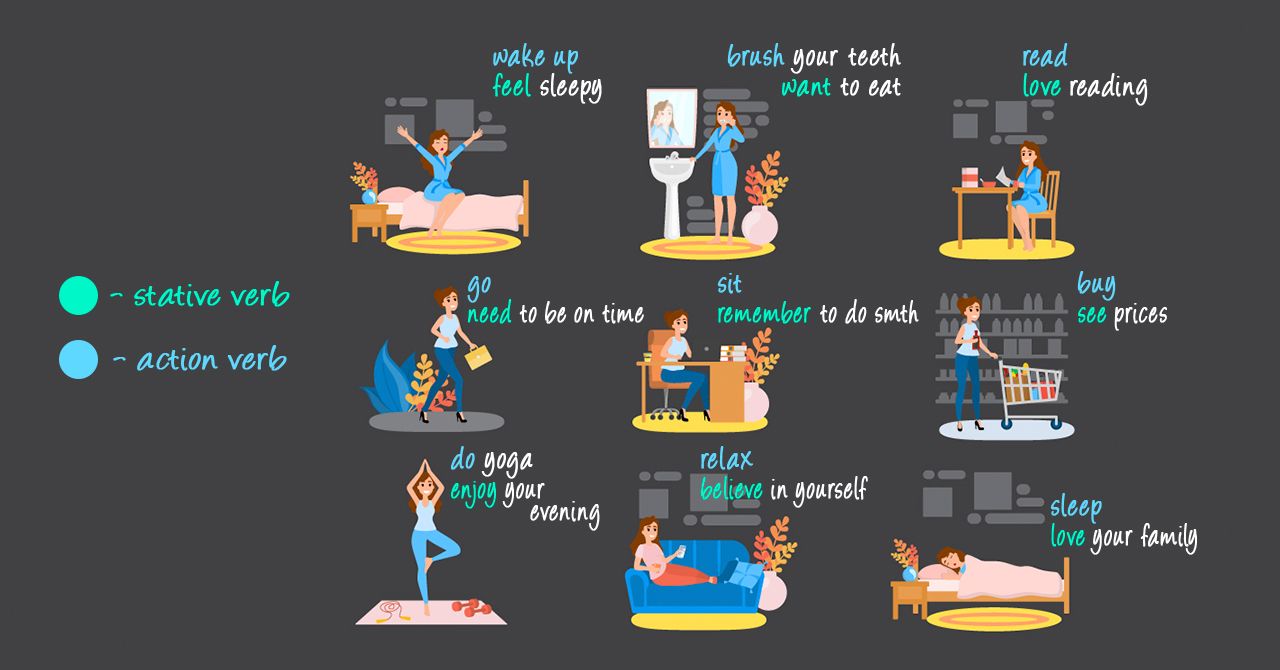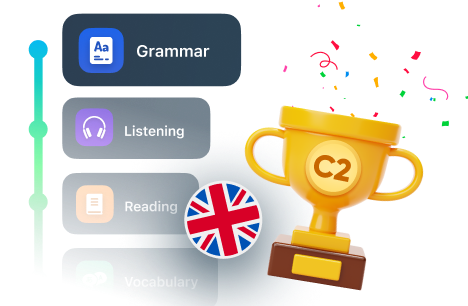
Lazy STATIVE or energetic ACTION verbs
In this article, I only wanted to emphasize that stative verbs are not used in any continuous form, which can be Present, Past, Present Perfect Continuous, etc.
While discussing the topics of Present Simple and Present Continuous, we eventually come across a list of verbs that aren’t used in the continuous form.
Once you find that list, you usually have two ways of dealing with it—either to learn it by heart or to understand it.
The first way might seem easier for some people because one can find a simple solution to a troubling problem. Although when they delve into the topic, they find that there’s still a lot to learn due to the ambiguity of some rules/verbs/words, which is often found in English. While reading this article, you’ll realize that understanding these verbs is easier than you expected. Let’s get started! 😊
Muscle work and ACTION verbs
So let’s imagine that you work, jump, run, drive, go and perform a lot of other actions. You want to say that it’s something that IS happenING at this particular moment. You choose to use Present Continuous to talk about these actions.
And the next question is whether work, run, or any other verb you want to use is a stative or an action verb.
To find the answer, you need to ask yourself two questions:
- Does this action require any muscle flexion?
- Does this action prevent you from performing any other action?
If you answered “Yes” to both questions—that is an ACTION verb.
Example:
(1) I’m running in the park now.
RUN is an action verb because when you run, your muscles flex (1st question).
(2) I’m lying on the couch at the moment.
LIE is an action verb because you can’t jump or swim and lie at the same time.
Even though you can read, there still are actions that you can’t perform (2nd question).
No action and STATIVE verbs
Now while working, jumping, running, driving, going, and performing a lot of other action verbs, you decide to start paying attention to what you are, what you feel, what you have, want. You know that these verbs also take place at this moment. And you think that you should choose Present Continuous when talking using these verbs.
But do you remember the questions?
- Does this action require any muscle flexion?
- Does this action prevent you from performing any other action?
Be (is/am/are), feel, have, want do not require muscle flexion. For example, you can do nothing when you feel something.
Be (is/am/are), feel, have, want do not prevent you from doing any other actions. For example, you can jump or sleep and want something at the same time.
You answered “No” to both questions. All that means that we deal with stative verbs. You can’t use ANY continuous form with stative verbs, so you choose the same non-continuous form (e.g. Present Simple instead of Present Continuous).
Example:
(1) I believe in myself at the moment!
BELIEVE is a stative verb because you don’t flex any muscle to believe (1st question) and you can believe and jump/sleep/sing, etc (2nd question). We use Present Simple even if it should be Present Continuous (at the moment) because it’s a stative verb!
(2) My friend doesn’t understand me today!
UNDERSTAND is a stative verb for the same reasons as in the first example.
Sum it up!
Now, since you’ve learned about two different types of verbs, I’d like you to look at this picture below.
You see a woman doing her daily tasks. Words in blue (upper) are action verbs, and others in green (lower) are stative verbs. You can now notice how a stative verb never interrupts an action verb.
Some of the sentences to describe these pictures can be:
- The woman is brushing her teeth and wants to eat.
- She is going to work and needs to be on time.
- She is doing yoga and enjoys her evening.

Confusion?
Easy? Cool! Now let’s delve into the topic and discuss some confusions you may encounter when dealing with stative verbs.
Disclaimer:
There’s absolutely no need to fully understand the information below if you’re new to this rule. This is for those of you who think that stative verbs are super clear and easy and for those who want to brainstorm.
So, do you remember the examples above? Look at them once again:
- The woman is brushing her teeth and wants to eat.
- She is going to work and needs to be on time.
- She is doing yoga and enjoys her evening.
I used Present Simple and Present Continuous in these examples, but it can be any other Simple or Continuous tense there if the context allows us to use one.
And, again, stative verbs will never be used in any Continuous form.
Let me give some examples:
(1) She was sitting at the table eating and still remembered what he had told her.
(2) I was reading, and although I wanted to eat, I didn’t want to stop because the book was so interesting.
In example (1), you can see two simultaneous actions SIT and REMEMBER. Sit is an action verb, and remember is a stative verb (due to stative/active distinguishing questions). So even though those actions were happening at the same time, you cannot use Continuous form with “remember” and that’s why you decide to use Past Simple with this verb. And you should choose Past Continuous for the action verb “sit.” This means that despite the context saying that it should be Past Continuous for both verbs, we choose a non-continuous tense (Past Simple) with “remember” due to its stativeness.
Ok, but are all stative verbs stative?
No, they aren’t. It’s not the verb that we’re looking at while choosing the tense or form of it. It’s the context and the meaning of this verb in that context.
So, let’s look at the examples:
(1) They have a nice big dog! And they bought some toys for their dog so it has some new toys now!
(2) Because their dog has nice new toys, they’re having such a good time playing together at the moment.
Remember the questions we use to distinguish between stative and active verbs:
3. Does this action require any muscle flexion?
4. Does this action prevent you from performing any other action?
In example (1), the verb TO HAVE (have/has) is stative because the dog does no muscle flexion to have those toys (question 1), and the dog can do any other action (sleep/eat/etc), and it will still have its new toys (question 2).
In example (2), the first TO HAVE (has) verb is also stative for the same reasons discussed above, but the second TO HAVE (are having) verb is active because in the context (to have a good time), it has an active meaning - to spend your time with pleasure. You can’t spend your time with pleasure and perform any other action at the same time (cry/sleep/argue/etc) (question 2), and you sometimes do have to flex your muscles to perform that action. So your answer is NO to both questions, which means that’s an action verb and can be used in Continuous tense if needed.
TO HAVE—stative—have a toy.
TO HAVE—active—have a good time.
Be careful with the context! 😊
Why are some perception verbs active and others—stative even though they have very similar translations?
This is a very nice question to ask! Look at the verbs “watch” and “see,” “listen,” and “hear.”
“Watch” and “listen” are considered to be action verbs, while “see” and “hear” are stative verbs.
Why? The answer is very simple—see and hear are the verbs that describe the ability to perceive visual and aural information unconditionally, so when we hear or see something, we can perform other actions at the same time and don’t flex any muscle (the questions).
Watch and listen are verbs that describe directed actions where you have to show some amount of focus. For example, watch a film or listen to music. If one tries answering our stative/active distinguishing questions when thinking about “watch” and “listen,” they will find out that the answer is YES to both of them, which means that those verbs are active.
That is what you should always keep in mind when you use verbs of perception.
REMEMBER
(!) You should know that if you want to use any stative or action verb, you don’t have to use any particular tense just because the verb is stative or action. Tense and grammar are something you choose from the meaning you want to put into what you’re saying. In this article, I only wanted to emphasize that stative verbs are not used in any continuous form, which can be Present, Past, Present Perfect Continuous, etc.
I hope you enjoyed reading this article and that it helped you to improve your language skills.


















